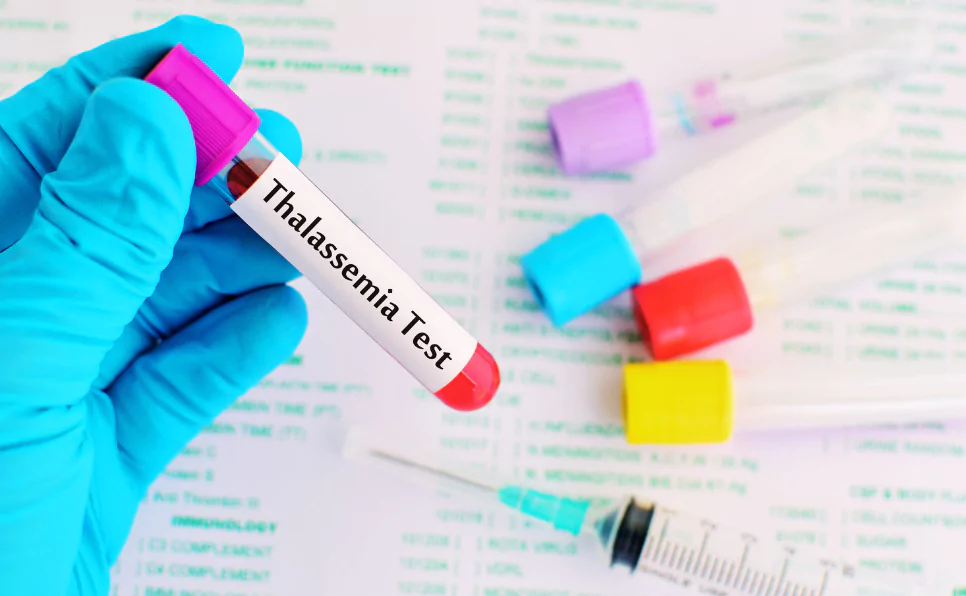Marfan syndrome is a condition that sneaks up on many families. You might not see it at first, but it’s there, woven into the DNA, making the body’s connective tissue weaker than it should be.
This isn’t just a matter of being tall or having long limbs – Marfan syndrome can mess with your heart, eyes, and more. It’s critical to spot this condition early because knowing about it can change course of treatment.
And that’s where genetic testing comes in, playing a front-and-center role.
It’s like having a high-precision map when you’re in unknown territory. Without it, you’re just guessing. With it, you’ve got the power to make informed decisions about health and treatment options.
Key Takeaways
- Marfan Syndrome can be effectively diagnosed with genetic testing.
- The FBN1 gene mutation is commonly associated with Marfan Syndrome.
- Early diagnosis through genetic testing can significantly improve the management of the condition.
Understanding Marfan Syndrome
Back in the day – we’re talking 1896 – a French doctor named Antoine Marfan met a girl who stretched her limbs further than anyone thought possible.
That meeting was the first step towards understanding what we now call Marfan syndrome.
It took years of head-scratching and research, but now we know that this isn’t a case of someone just being flexible or lanky; it’s a genetic condition.
The Clinical Features of Marfan Syndrome
We’re looking at a bunch of signs that might make you think “Marfan” – like:
- arms that seem too long for the body
- fingers that look like they could play piano in their sleep
- chest that might be indented or sticking out.
But there’s more to it. People with this syndrome often have issues with their eyes, like lens dislocation, and they can have a curve in their spine too.
The big worry, though, is the heart. The aorta, the main artery, can get weak and stretch, a problem you don’t want to mess with.
How Marfan Syndrome Affects the Body
It’s not just about being tall or flexible. Marfan syndrome can go after the body in a lot of ways, often where you can’t see it.
The most dangerous part is what it can do to your heart and blood vessels.
But it doesn’t stop there; it can affect your bones, eyes, skin, and lungs. It’s a bit like having a glitch in the body’s building plans – things don’t always end up as strong or as sturdy as they should.
The Science of Genetic Testing
When it comes to figuring out if someone has Marfan syndrome, we’ve got genetic testing. It is used to look right into the DNA, the tiny code in our bodies that makes us who we are.
Basics of Genetic Testing for Disease Diagnosis
When doctors suspect Marfan syndrome, they send off a blood sample to a lab to look for specific changes in the DNA – these are called mutations.
It’s a bit like finding a typo in a word – it might not seem like much, but it can change the whole meaning.
Now, we’re in an era where technology is booming – and genetic testing is riding that wave too.
Back in the day, this stuff was time-consuming and expensive.
But now, thanks to techy advances, we can do it faster, better, and cheaper.
The FBN1 Gene and Its Role in Marfan Syndrome
If Marfan syndrome had a most-wanted list, the FBN1 gene would be at the top.
This little strip of DNA is usually the troublemaker when it comes to Marfan.
If it’s not doing its job right, that’s when you get problems with connective tissue – and all those symptoms we talked about before.
Finding a mutation in the FBN1 gene is like hitting the jackpot for diagnosis – it gives you answers.
But this is not the only gene associated with Marfan. At least five other genes TGFBR1, TGFBR2, SMAD3, TGFB2, and TGFB3 have been linked to it.
The Diagnostic Process for Marfan Syndrome
Getting to the heart of whether someone has Marfan syndrome is a step-by-step deal. It’s a mix of old-school doctor know-how and high-tech genetic insight.
Initial Clinical Assessment
Before we even think about genetics, doctors take a good look at what’s going on.
They check out the family health history, because this thing can run in families, and they look for those tell-tale signs – like arms and legs that are longer than the norm or a chest that’s shaped a bit differently.
They also take a good look at the eyes and the heart.
Criteria for Genetic Testing for Marfan Syndrome
Not everyone who walks into a doctor’s office needs their genes checked for Marfan syndrome.
So, doctors have this checklist – if you tick enough boxes on it, like having a certain score on a system that measures Marfan features, then bam, you’re in for genetic testing.
They’re especially keen if your heart’s involved because nobody messes with the heart.
Understanding the Results of Genetic Tests
Now, getting the results from a genetic test can be like reading a foreign language. But here’s the thing – if they find a change in that FBN1 gene, it’s a strong sign that Marfan syndrome is in the picture.
Sometimes, though, it’s not so clear-cut, and that’s when doctors and genetic counselors help. They help make sense of the jargon so you know exactly what you’re dealing with.
Challenges and Considerations in Genetic Testing
Genetic tests are amazing, but they’re not flawless. They’re like weather forecasts for your genes – mostly right, but sometimes they miss a storm.
There can be false alarms and missed calls. Doctors have to piece together clues from tests and what they see in front of them to make the right call.
- Sometimes a test says you have a gene change, but you never get the condition – that’s a false positive.
- Other times, you might have the condition, but the test doesn’t spot it – and that’s a false negative.
- Plus, there are times when a test finds a gene change, but no one knows what it means – these are called variants of uncertain significance.
Ethical Considerations in Genetic Screening
And then there’s the tough questions, the ones that get you thinking about more than just science.
Like, should everyone get tested for every possible condition?
What happens if an insurance company gets their hands on your genetic info?
And who decides what to do with the knowledge that you or your kids could get sick in the future?
It’s a minefield of ‘what ifs’ that we’re all still trying to navigate.
Living with Marfan Syndrome
Life doesn’t come with a manual, and if you’ve got Marfan syndrome, sometimes it feels like you’re trying to build a puzzle without the picture on the box.
It’s about managing what you’ve got, day in, day out, and making sure you’ve got the best quality of life possible.
Treatment and Management of Marfan Syndrome
For managing Marfan syndrome doctors usually have a plan that includes regular check-ups, because you gotta keep an eye on the heart, above all.
Medication to keep the blood pressure low can take some pressure off the aorta, which is crucial.
Sometimes, surgery is on the table, especially if the aorta’s getting too big or if there are issues with the valves.
- Regular heart and eye check-ups are non-negotiable.
- Medications like beta blockers or losartan can be life-savers.
- Surgeries, when needed, can prevent life-threatening complications.
Lifestyle Adjustments and Coping Strategies
Now, living with Marfan syndrome means some things in life need a tweak.
Contact sports? Probably not the best idea. Skydiving? Let’s just say there are better hobbies out there for you.
But there’s still a whole world of activities you can enjoy. And it’s not just about physical health – mental health is big too.
Finding ways to deal with stress, talking things out, and keeping your spirits up are all part of the game.
Support Networks and Resources
Having Marfan syndrome may feel lonely, but there are a bunch of people out there who get it.
Support groups, whether online or in person can be a lifeline. There are also organizations dedicated to Marfan syndrome that provide a heap of resources, from the latest research to tips on managing day-to-day life.
FAQs
What are the first signs that might indicate Marfan Syndrome?
If you’re spotting things like spider-like fingers, a wing span longer than your height, or a chest that pops out or caves in, take note. Those could be the early whispers of Marfan Syndrome, tapping on your shoulder.
Can Marfan Syndrome be diagnosed without genetic testing?
Yes, Marfan Syndrome can sometimes be spotted without a deep dive into your DNA, especially if it’s written all over your body with features that doctors recognize from a mile away.
How does genetic counseling help families with Marfan Syndrome?
Genetic counseling is like having a personal guide in the Marfan maze. It helps families understand the what’s and if’s of the condition, and how to deal with the possibility of it hanging around in the family tree.
What are the chances of passing Marfan Syndrome to children?
If you’ve got Marfan Syndrome in your genes, it’s like a coin flip – there’s a 50/50 shot your kids will inherit it. It’s the kind of odds that make genetic counseling super valuable.
Are there any new developments in genetic testing for Marfan Syndrome?
The world of genetic testing for Marfan Syndrome is always on the move. The latest tech lets us zoom in on the FBN1 gene with more accuracy, so we’re getting better at predicting and managing the condition.
Further Reading
- FBN1-Related Marfan Syndrome – Genereviews
- Marfan syndrome. Part 1: pathophysiology and diagnosis – Nature Reviews Cardiology
- Clinical and molecular study of 320 children with Marfan syndrome and related type I fibrillinopathies – Pediatrics
- Medical management of Marfan syndrome – Circulation
- Classical and neonatal Marfan syndrome mutations in fibrillin-1 cause differential protease susceptibilities and protein function – Journal of Biological Chemistry

Dr. Heena Arora, a passionate geneticist and microbiologist, is a valuable asset to the Genes Wellness team. Her seminal work includes identifying a key gene for white rust resistance in mustard. Leveraging her deep expertise in genetics and microbiology, she ensures the accuracy and integrity of our content. Dr. Heena’s commitment to knowledge dissemination makes her an integral part of our team.





